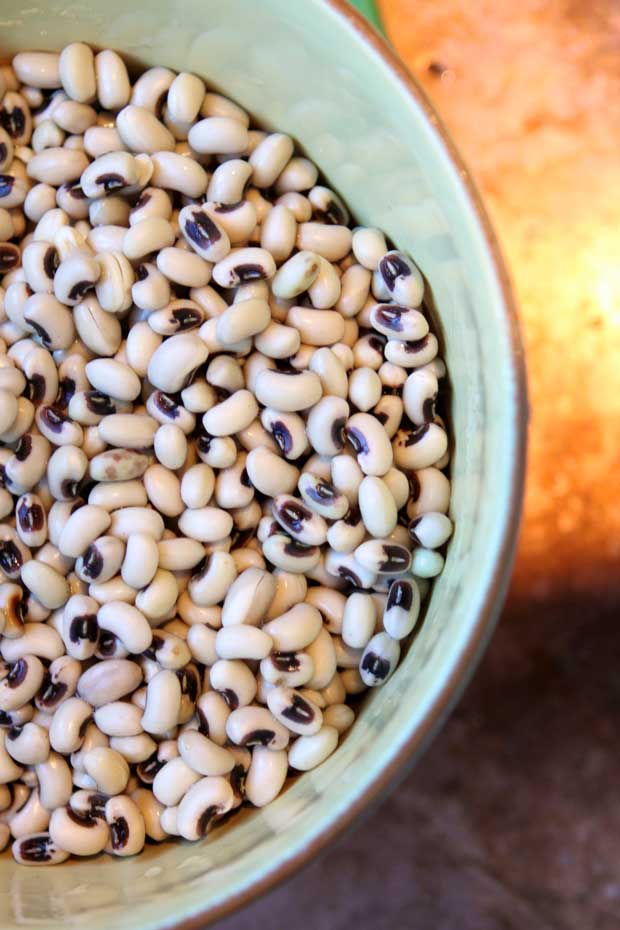December 22, 2011

I always make black-eyed peas on New Year’s Day. The lore is that eating these beans on the first day of January will bring a year filled with luck and prosperity. Who couldn’t use a little bit of that these days?
This dish is total comfort food, as in comfort for the inebriated daze that follows a great New Year’s Eve. Last year, on New Year’s Day, all of us stood around the kitchen island, the worse for wear from the previous night’s indulgences and found comfort in this version of black-eyed peas. As we laughed and reminisced about the night before, we sopped the beans up with some cornbread and slurped our Bloody Marys.
I updated this traditional dish to give it a little Santa Barbara flair by adding jalapeños, pancetta and smoked tomatoes (which give it a campfire richness). It has a stick-to-your-ribs heartiness that helps cure that post-party trauma and maybe helps you find a little luck, too.
A traditional black-eyed peas recipe calls for a ham hock, but I didn’t have one the first time I made it so I tried using pancetta. It worked and made really a delicious and flavorful dish, plus it put a New World spin on an Old World classic.
Notes:
Soaking the beans: Yes, you can soak the beans the night before, but I find an hour or two is plenty, especially if you’re using fresh beans. Cover the beans with cold water, and be sure to use a big bowl; the amount of water that gets soaked up is amazing.
Cooking the beans: I think it’s Anne Burrell who talks about the five-bean-test tip. When you’re checking to see if the beans are done, be sure to try five beans from the pot; it’ll give you a more accurate reading of whether all of the beans are cooked completely.
1 pound died black-eyed peas (soaked overnight in the fridge, or 2 hours at room temp prior to cooking)
1 tablespoon olive oil
4 ounces pancetta, large diced
1 yellow onion, chopped
2 teaspoons garlic, chopped
1 jalapeño, diced, and seeds removed
2 dry smoked tomatoes, chopped* (optional) (I find mine at the farmers market)
1/2 teaspoon freshly ground black pepper
1/4 teaspoon cayenne pepper
7 cups water
3 teaspoons salt
Savoy cabbage, shredded, for garnish
[*If you can’t find dry smoked tomatoes, substitute 2 sun-dried tomatoes, chopped, with 1/4 teaspoon of smoked paprika—that should do the trick.]
Sauté the pancetta and onion in the olive oil on medium high heat until the fat is rendered—about 15 minutes. Add the black and cayenne pepper during this cooking time.
Add the garlic, jalapeño, and optional tomatoes. Cook for 2 minutes, stirring to incorporate. Add the beans, water and bay leaves, and bring to boil. Lower to a good simmer and cook for 1 1/2 hours. From time to time skim off the muck that accumulates at the top of the water. After the beans are cooked (they’ll be nice and tender), remove the bay leaves and mash some of the beans on the side of the pot with a large wooden spoon to get a thicker consistency.

Finally, stir in the 3 teaspoons of salt. It may seem like a lot of salt, but remember, you’re cooking a whole pound of beans. And if you add the salt before the end of the cooking process, the beans will get loose and their skins funky.
Serve in a bowl with the shredded savoy cabbage on top. (I like also to drizzle some good-quality olive oil over the top.) If you want to pull out all the Southern stops, you can serve it with cornbread (which is supposed to represent gold—and since gold is so valuable right now—go for it!).